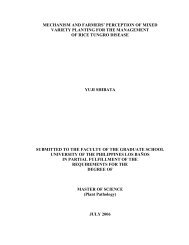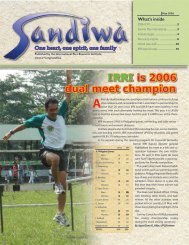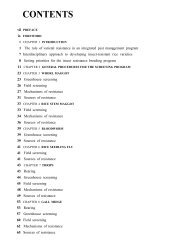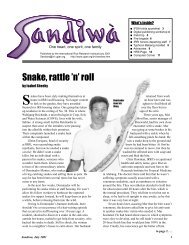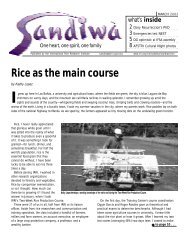Untitled - International Rice Research Institute
Untitled - International Rice Research Institute
Untitled - International Rice Research Institute
You also want an ePaper? Increase the reach of your titles
YUMPU automatically turns print PDFs into web optimized ePapers that Google loves.
Functions of seed health testing<br />
Seed health testing is done to determine microbial<br />
infection or contamination for quarantine purposes<br />
(e.g., international seed exchange or movement). It<br />
identifies the cause of seed infection that affects the<br />
planting value of seed lots for seed certification by<br />
seed growers to supply seed to farmers. Seed testing<br />
affects policies on seed improvement, seed trade,<br />
and plant protection. Neergard (1979) brought out the<br />
importance of pathogens carried by seeds and the<br />
disease potential assigned to pathogens.<br />
Several routine activities are undertaken during<br />
seed health testing. These include dry seed inspection,<br />
the standard blotter test for seed infection and<br />
contamination, postentry planting for field inspection<br />
of undetected plant diseases of seedborne and seedcontaminated<br />
pathogens, and certification. In seed<br />
multiplication for export, crop inspection prior to seed<br />
harvest offers an additional means to link seedborne<br />
pathogens and diseases of mother plants. All these<br />
activities provide preventive measures to eliminate<br />
the introduction of undesirable pathogens into a region<br />
or country. Seed health testing offers a powerful<br />
tool for documenting microorganisms associated with<br />
seeds. Information on microorganisms, however,<br />
needs to be associated with a database on yield loss<br />
and information on pathogens that cause diseases.<br />
Catalouging pathogens of crops<br />
For rice, seed health testing has been done on more<br />
than 500,000 seed lots following <strong>International</strong> Seed<br />
Testing Association (ISTA) rules (1985). A total of<br />
more than 80 fungi were detected on rice seeds<br />
(Table 1). The detection frequency varied. About 20<br />
species of fungal pathogens were detected from rice<br />
seed at any one time. Not all of them cause notable<br />
diseases in the field and it was not ascertained<br />
whether diseases were all seed-transmitted and, if so,<br />
what their transmission efficiency was. The role of a<br />
rice seed in a fungus life cycle is not clear.<br />
Pyricularia oryzae, the rice blast pathogen, although<br />
considered a very important rice pathogen,<br />
has the lowest detection frequency. The level varied<br />
according to seed source. Except Fusarium<br />
moniliforme, the seedborne inoculum of the other<br />
pathogens may not serve as an important source of<br />
secondary inoculum in the field. The infection level<br />
of P. oryzae is likely to be higher in temperate or<br />
subtropical environments than in tropical environments.<br />
The data set provides insights into the occurrence<br />
of rice fungal pathogens. The detection frequency<br />
and infection level are very high for Alternaria<br />
padwickii (80–90%) (Fig. 1). In tropical Asia,<br />
stackburn, the disease it causes, is hardly observed in<br />
the field.<br />
Detection methods<br />
Many detection methods have been developed over<br />
the years for various seedborne pathogens. We found<br />
the blotter test to be a common but efficient method<br />
of detecting seedborne fungal pathogens in rice seed.<br />
Following ISTA rules, the method involves plating<br />
400 seeds on some layers of moistened filter paper.<br />
Below is a list of the different detection methods used<br />
in routine seed health testing. Descriptions of these<br />
methods can be found in the references listed (see<br />
page 82).<br />
Seed health testing procedures involve techniques<br />
such as<br />
• Direct examination of dry seeds<br />
• Examination of germinated seeds<br />
• Examination of organisms removed by washing<br />
• Examination after incubation (both blotter and<br />
agar plates)<br />
• Examination of growing plants (for example,<br />
the seedling symptom test)<br />
• Embryo count methods<br />
• Molecular and serological techniques<br />
Other methods include a selective medium for<br />
specific pathogens. With advances in molecular<br />
techniques, emphasis in fungal identification and<br />
taxonomy has changed from a morphological approach<br />
(for example, spore size and spore shape) to<br />
a more functional approach based on aspects of the<br />
life cycle, mechanisms of spore production and release,<br />
DNA relationships, and physiological attributes.<br />
DNA analysis techniques such as the polymerase<br />
chain reaction (PCR), and random amplified<br />
polymorphic DNA (RAPD) analysis are the most<br />
commonly used tools.<br />
These are powerful techniques for detecting and<br />
for establishing the relationship between the inocu-<br />
3



